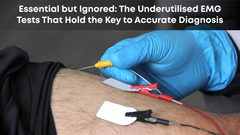Understanding Optic Neuritis: Causes, Diagnosis &Treatment
What is Optic Neuritis?
Optic neuritis is an inflammatory condition that affects the optic nerve, the nerve responsible for transmitting visual information from the eye to the brain. This inflammation can result in sudden vision loss, typically in one eye, accompanied by pain, especially during eye movement. While optic neuritis can occur at any age, it is most commonly diagnosed in young adults between the ages of 20 and 45 and is more prevalent in women than men.
What Causes Optic Neuritis?
The exact cause of optic neuritis is often unclear, but it is frequently associated with autoimmune disorders, where the body's immune system mistakenly attacks its tissues. Some common causes and associations include:
> Multiple Sclerosis (MS): A significant number of optic neuritis cases are linked to multiple sclerosis, a chronic autoimmune disease that affects the central nervous system. Optic neuritis may be the first sign of MS, with up to 50% of people with optic neuritis developing MS within 15 years.
> Neuromyelitis Optica (NMO): Also known as Devic's disease, NMO is another autoimmune condition that can cause optic neuritis. Unlike MS, NMO predominantly affects the optic nerves and the spinal cord.
> Infections: Certain infections, such as Lyme disease, syphilis, and viral infections (e.g., herpes, Epstein-Barr virus), can cause optic neuritis.
> Autoimmune Diseases: Other autoimmune conditions, such as lupus and sarcoidosis, can also be associated with optic neuritis.
> Medications and Toxins: Some medications, such as certain antibiotics and immunosuppressive drugs, as well as exposure to toxins, can induce optic neuritis.
How is Optic Neuritis Diagnosed?
Diagnosing optic neuritis involves a combination of clinical evaluation, imaging studies, and specialized tests to assess the function of the optic nerve. The diagnostic process typically includes:
> Clinical Examination: An ophthalmologist or neurologist will perform a thorough examination, including a detailed medical history and visual acuity test to assess vision loss. They will also check for color vision deficits and a relative afferent pupillary defect (RAPD), an abnormal response of the pupils to light.
> Optical Coherence Tomography (OCT): OCT is a non-invasive imaging test that provides detailed cross-sectional images of the retina. It can detect thinning of the retinal nerve fiber layer, which is indicative of optic nerve damage.
> Magnetic Resonance Imaging (MRI): MRI of the brain and orbits (eye sockets) is commonly used to visualize inflammation and demyelination (loss of the protective covering of the optic nerve fibers). MRI can also help identify lesions in the brain that are suggestive of multiple sclerosis.
> Visual Evoked Potentials (VEP): VEP is a specialized test that measures the electrical activity in the brain in response to visual stimuli. It helps assess the conduction of visual signals through the optic nerve and can detect delays or abnormalities indicative of optic neuritis.
Role of EMG-Visual Evoked Potential (VEP) Test in Diagnosing Optic Neuritis
The EMG-Visual Evoked Potential (VEP) test plays a crucial role in diagnosing optic neuritis. VEP measures the electrical activity generated by the brain's visual cortex in response to visual stimuli, typically patterns or flashes of light. Here's how it works:
> Procedure: During the VEP test, electrodes are placed on the patient's scalp over the occipital lobe, the brain region responsible for processing visual information. The patient is then shown visual stimuli, and the electrical responses are recorded.
> Detection of Abnormalities: In patients with optic neuritis, the conduction of visual signals along the optic nerve is often delayed due to inflammation and demyelination. The VEP test can detect these delays, which are seen as prolonged latency in the recorded signals.
> Sensitivity and Specificity: VEP is highly sensitive in detecting even subtle abnormalities in the visual pathways, making it a valuable tool for diagnosing optic neuritis, especially in cases where other tests may not show clear results.
Treatment for Optic Neuritis
The treatment of optic neuritis primarily focuses on reducing inflammation, managing symptoms, and addressing any underlying conditions. Common treatment options include:
> Corticosteroids: High-dose intravenous corticosteroids, such as methylprednisolone, are the standard treatment for acute optic neuritis. They help reduce inflammation and can speed up recovery of vision. This is usually followed by a tapering course of oral corticosteroids.
> Plasma Exchange Therapy (Plasmapheresis): In severe cases of optic neuritis or when corticosteroids are ineffective, plasma exchange therapy may be considered. This procedure involves removing and replacing the patient's plasma to eliminate harmful antibodies.
> Treatment of Underlying Conditions: If optic neuritis is associated with an underlying condition such as multiple sclerosis, neuromyelitis optica, or an infection, appropriate treatment for the primary condition is necessary to prevent further episodes.
> Immunomodulatory Therapies: In cases linked to multiple sclerosis or neuromyelitis optica, long-term immunomodulatory therapies such as interferons, monoclonal antibodies, or other disease-modifying agents may be prescribed to reduce the frequency of relapses and slow disease progression.
How Clarity Medical's EMG-EP-NCV Devices are Impacting the Diagnostic Industry
Clarity Medical's EMG-EP-NCV devices have revolutionized the diagnostic industry. These devices offer several advantages in diagnosing conditions like optic neuritis:
> High Precision and Accuracy: Clarity devices provide high-precision recordings of electrical activity, ensuring accurate and reliable results for VEP tests. This precision is crucial for detecting subtle changes in visual pathway conduction.
> User-Friendly Interface: The devices are designed with a user-friendly interface, making it easier for healthcare professionals to perform and interpret VEP tests. This accessibility enhances the efficiency of the diagnostic process.
> Portability and Versatility: Clarity Medical's devices are portable and versatile, allowing them to be used in various clinical settings, including hospitals, clinics, and research institutions. Their portability ensures that patients in remote or underserved areas have access to high-quality diagnostic services.
Conclusion
Optic neuritis is a significant condition that can lead to vision loss and is often associated with autoimmune diseases such as multiple sclerosis. Early and accurate diagnosis is crucial for effective management and prevention of long-term complications. The EMG-Visual Evoked Potential test is a valuable tool in diagnosing optic neuritis, providing detailed insights into the conduction of visual signals.












